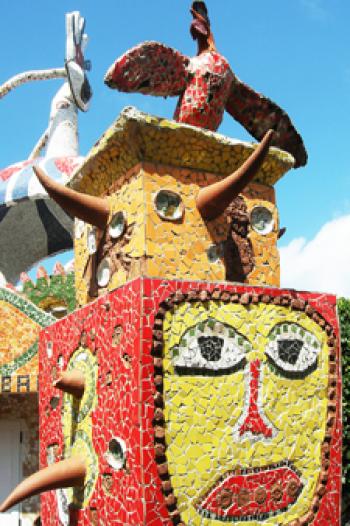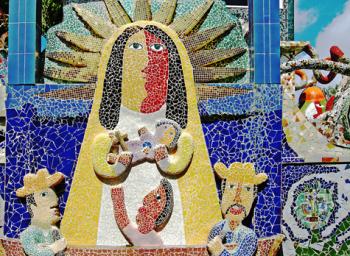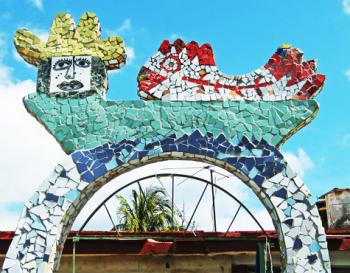Cuba’s Fusterlandia
This item appears on page 32 of the August 2017 issue.
Photographs and descriptions don’t do it justice. The artistic genius of José Rodríguez Fuster should be experienced firsthand by visiting Jaimanitas, a suburb west of Havana.
Since the mid-1970s, José Fuster has covered nearly every space on his property with mosaics made primarily from broken tiles in primary colors. Everywhere, there are images of gauchos, amorous couples, boats, fish, various sea creatures and abstract female nudes.
The prolific exuberance of the artist’s creativity has expanded outside his property into much of the small village of Jaimanitas, which surrounds Fusterlandia.
Fuster has been called the “Picasso of the Caribbean” and a follower of the Catalan architect Antonio Gaudí. I feel that both designations are too limiting. While the influences of Picasso and Gaudí are there, his work is unique in its own right.
If Fuster is to be categorized, he should be seen as a “primitive,” self-taught, outsider artist. His work embodies a whimsy and childlike quality quite unlike the more sophisticated works of Picasso and Gaudí. His work also has the characteristics of street and public art.
Fuster’s works are primarily 2-dimensional and limited to ceramics, tiles and mosaics, although some works are excellent pieces of sculpture in their own right.
Two of his large mosaic murals qualify, in my estimation, as masterworks. One appears to be a representation of Noah’s Ark, and the other is a manifestation of the Virgin Mary, who is crowned as the Queen of Heaven and is holding a small cross and the infant Jesus.
Although having exhibited primarily in Cuba, Fuster has received international attention at exhibitions in Romania, India and England.
Admission to Fusterlandia is free. Also, it is possible to see Fuster in person and to purchase original tiles created by him in his workshop.
Notable mosaic murals by other artists in Fuster’s neighborhood include a wall created as an homage to Antonio Gaudí and a mural depicting Fidel Castro’s arrival in Cuba from Mexico on his yacht Granma.
My visit to Fusterlandia was part of the tour “Flavors & Colors of Cuba,” April 21-29, 2017, organized by Spiekermann Travel Service (Eastpointe, MI; 800/645-3233, www.mideasttrvl.com).
For those permitted to travel independently, transportation to Fusterlandia is probably best arranged with a driver of one of the classic-car taxis located on central Havana’s Paseo del Prado. On the Internet, fares are cited as ranging from CUC12 to CUC15 (near $12-$15).
Transportation is also said to be available on Havana’s public buses as well as on select hop-on, hop-off buses.
The short visit to Fusterlandia was a highlight of my trip to Cuba and definitely worth the side trip outside central Havana.
DAVID J. PATTEN
St. Petersburg, FL



